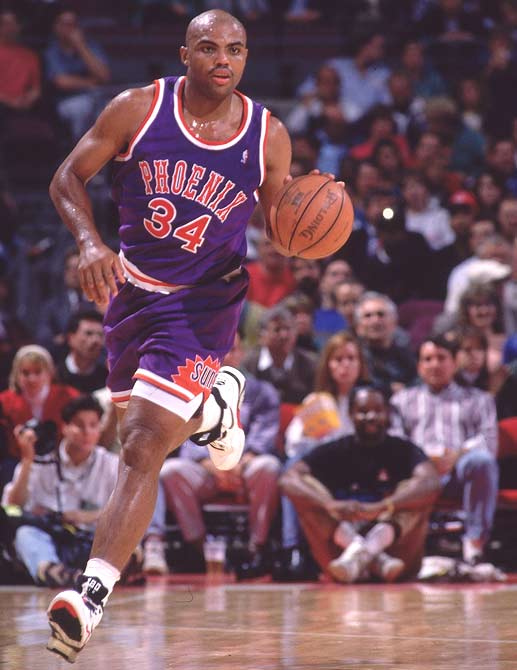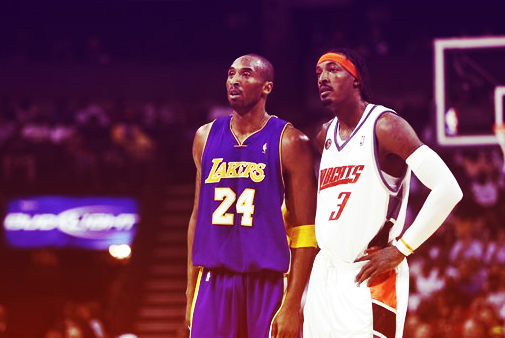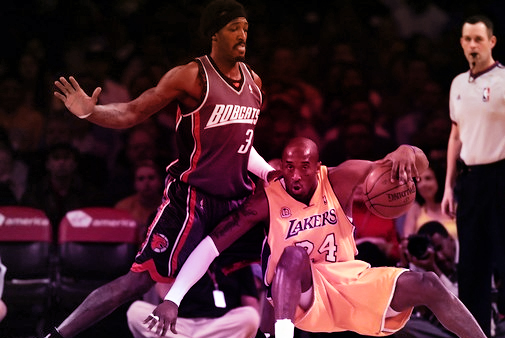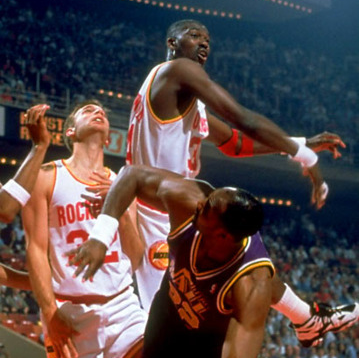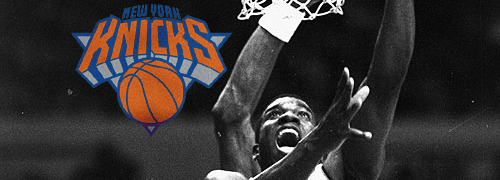Eye on the Classics: Where the Fox Knows Many Things...
Posted on Fri 25 November 2011 in Eye on the Classics by Alex Dewey
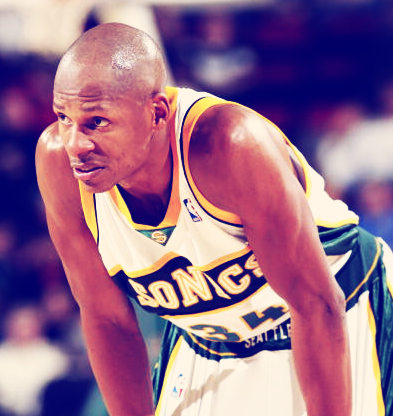
"The fox knows many things, but the hedgehog knows one big thing."
--Isaiah Berlin, quoting Archilochus
Ray Allen is the ultimate hedgehog and Steve Nash is the ultimate fox, in Berlin's famous dichotomy of historical geniuses. This placement of Allen and Nash is true, but difficult to write about, largely because the argument is so straightforward if you understand both players (and also because Berlin's dichotomy is - as Berlin knew - flawed at its core). We're rolling with it, though, so as to uncover the mystery of chessboxing; that is, the essence of these two athletic geniuses. Nash is the fox and Ray is the hedgehog. Game on.
Anyway, in 2006, Nash and Allen both led their Suns and Sonics to a high-scoring, double-overtime classic. A dual for the ages. It's the kind of game that would've had highlights running on SportsCenter for weeks. That is, if it hadn't happened on the exact same night Kobe dropped 81 on the defenseless Raptors. Some based uploader (MrMagic2worthy) uploaded the whole thing to Youtube, and yes, it's more than 2 hours long, but I have to say: this is a must-see. Click the jump for the videos, and a whole wheelbarrow of words.
• • •
THE INTRO (or: a toast to Nash)
I sing the bodies electric. Watching this hypnotic 20-minute shooting drill by Nash, you're struck by how consistent and accurate the Canadian point really is as a shooter, even knowing his stats and having watched his jumper in games. Nash's shots are - at least in his lower body - variations on a hopping theme: His pull-ups and jumpers use his toes and calves more; he kicks his right leg out more on fadeaways to draw fouls and create space; he lifts his knee much higher on layups. And the shots in the drill invariably form one indivisible motion of his upper-body. It's an integrity and an economy of motion that virtually guarantees he'll get within inches of the center of the basket. With athletes that possess body control like Nash, it's no wonder airballs are so rare in the NBA. And every step Nash takes in this drill outside of shooting is exactly the same: An uncannily efficient flat-footed step with a bit of a knee-jerk that can go any direction at any point mid-step. It's all so fundamentally sound, and looking at it, my first thought was to compare it to Ray Allen, one of the great shooters of his generation and of all time.
I say this all not just to praise Nash. No, his 20-minute drill shows us - in its absence - what's so odd about Nash's "core" as a player in actual games: Nash has "fundamentals" the same way Deep Blue has skills to move a knight around the board: Perfectly and trivially. When he sets up for a shot and goes through the motions correctly, he will hit that shot. He will hit that open man, he will hit that lane. 99%. And yet for all his fundamentals, we don't think of them when we're watching him. He plays with the perfect fundamentals of Basketball's Deep Blue, but I'll be damned if he doesn't play a fun, deceptive, brilliant game of chessboxing. What we think of as the "fundamentals" are so far buried beneath the baroque complexity of Nash's basketball prowess that it doesn't make much sense to appeal to them. In the case of Nash, it all starts with his motion: That simple flat-footed stride - that seems merely efficient and repeatable in the drill - becomes something totally new in games: That same stride becomes a psychophysical masterpiece of economy, the chessboxer's twisting, contorting lower axis. When he has to react to game situations, Nash moves like a weird propeller motor atop another propeller motor, connected by a universal joint at the waist. He moves in three dimensions with two independent motors, all without losing his dribble. His mechanics let him suddenly move any direction and approach that direction from any angle. Structural integrity seems to give way totally to malleability and degrees of freedom.
And that's just his motion. Nash uses his unique motor - on seemingly every offensive possession - to do something psychophysically crazy that no one quite understands, in order to push past the most wily of defenses. These neat pull-ups we see in the drill become abrupt, creative fallaways over Tim Duncan closeouts. These neat "dribble-stop-fadeaway" sequences that Nash drills become long, impossible-to-articulate-fully sequences that can last .1 or 23.9 seconds (averaging about 7 seconds, heh.) in games and might end with him passing to the wing 48 feet away out of a trap on the baseline. Defenses are designed - in the broadest sense - to make offenses imperfect as much as possible. But Nash has none of that. Even on the most deliberate and obvious of pick and rolls, Nash seems always to have an extra option or three in the back of his head, and even the most straightforward of his options have an extra flash of difficulty to them. His offense can't help but be remarkably efficient and fun to watch. Sure, the SSOL Suns (and the Finley-Dirk-Nash Mavs) were both loaded on offense, but as we've seen in the slow unraveling of the Suns franchise, Nash can take mediocre and D-league players to 40 wins, and a decent second option to 55 wins. He is quite simply a candidate for GOAT offensive point guard. Has any player so consistently made all of his teammates (from the D-Leaguers to the HOF) look so much better on offense? Bad offenses seem to be short a player against the most pedestrian of defenses. Great offenses seem to be short a player against the best defenses.
In both cases, that short player that they're missing is Steve Nash.
THE GAME (or: the Hedgehog beasts it)

In this particular game, Nash was typically brilliant, putting up a 28-8-16 line on 20 shots. His passes - as is his wont - made the very good Raja Bell and Leandro Barbosa both look like... well, Ray Allen. Add to this that he was the primary ballhandler and only suffered five turnovers in a game where the pace was frantic, and you have yourself the average everyday night in the toolbox of a legend. And don't dally around it: the pace was as frantic as you'll see in the modern era, with both teams combining for 212 shots, 52 free throws, and 32 turnovers. The Suns went 18-38 from 3-point land and you have to think (correctly) that most of these shots came on an assist or a hockey assist from Nash. And yet, for that many passes, most of them no-look to a rotating man on the perimeter, Nash botched maybe two of them. He botched perhaps two transition plays, too. And he got the ball stolen from him once. For most players and games 5 TO is a mediocre percentage, but it's kind of incredible in context with the pace and the degree to which the offense ran through Nash.
Unfortunately for Nash, this fifth turnover came a few seconds before the end of the first overtime with the game tied, where a singularly amazing Luke Ridnour went around the great dribbler and forced Nash to turn it over out of bounds 40 feet from the basket, giving the Sonics one last chance (a failed Rashard Lewis shot) and sending the game to double-overtime. Now, let's be clear -- this post is about Ray-Ray and Nash, and I don't want to get too distracted. And Ridnour himself is an average (okay, a bit below average) starting PG, but his fast-paced style appears to lend itself to these kinds of insanely fast, efficient games. Take this observation as a cherished aside: take a look at these games in which both teams scored 50 FG on better than 50% shooting. Of the nine such games since this one, 3 involved Nash (duh) and 2 involved Ridnour. Luke Ridnour's ceiling is apparently to make a game unforgettable, and he did a great job in this game, honestly matching the HOFer drive for drive. A decent ceiling for a career roleplayer, I'd say.
Of course, matching Steve Nash cowlick for cowlick, drive for drive, in the Seven Seconds or Less era would hardly be enough to send the game into overtime, much less double-OT. You need a transcendent talent to do that. Enter Ray "He Got Game" Allen. Kinematically, Jesus Shuttlesworth is the complete inverse of Nash: Allen simply possesses (and applies consistently in games) a degree of structural integrity unmatched by any NBA player I have ever seen. Allen brings the Nash drill to the game, every game. Every single move Ray makes is from his whole body in one atomic, complex motion. It's like the game is his drill.
Ubiquitous in mastering physical skills is the idea of letting the object be an extension of your body. But how much control do we really have over our body? Ray Allen more or less gives us the upper bound, it's fair to say. For something to be more an extension of Ray's body than the ball during his jumper (or a golf club during his swing), it would have to more or less fuse surgically with him and then spend 38 more years learning the ins and outs. His three-point jumper is about as pure and beautiful as any individual action in sports, and you get the sense that - unguarded - Ray could hit a shot from every location on the halfcourt with at least 60% accuracy, blindfolded. And unlike (say) Tim Hardaway or Stephon Marbury (two of his lesser shooting contemporaries that could god-mode a half-courter now and again), Ray's 40-footers don't seem like swag highlight plays but the result of rational, obsessive calculation. As one of the most obsessive player in the league (he literally has OCD, as Aaron will get further into in his upcoming player capsule), his form and decision-making are fairly immaculate. Ray is a bit slower now, but in his prime he was a true triple threat, a complete, efficient SG with speed and decent defense. As it stands right now, he's merely the greatest shooter in the history of the league.
Anyway, Ray Allen made 32 of his 42 points in the last 19+ minutes to end this game. Okay, so read that again, please, because I don't have them time to garner redundant enthusiasm for an obviously insane fact. (Okay, there have been quarters with players scoring 33 points, and Charles Barkley scored 27 in one quarter in a game I reviewed. But these are historical level performances, and Ray's performance belongs with them.). Sure, his second half started slow, but so did his decisive match against Denzel Washington. Ray Allen's run started with a three-pointer on the wing, moving from there outward in a spiral to two borderline-deadball afterthoughts from 30 feet at the sidelines (only one of which counted!). Then he moved to a swag step-back 3 at the top of the key at the end of regulation, and finally - in a dagger seconds before the end of the second OT - Ray made a 32-foot shot whose trajectory you could place a steep barn under. It was one of those great games that Ray's obsession and kinesthetics are tailor-made to create.
THE CLOSE (or: the misallocation of genius)
Of course, Ray's approach has its drawbacks: while Ray's individual offensive skills may rival Nash's, I nevertheless doubt that his obsession and perfect structural integrity lend themselves well to the unending sequence of fakes and endless imperfect options that form what we call "running an offense". Even if he had the ability to make the passes (which in many cases he couldn't), I can't picture Ray Allen putting on a nightly assist clinic. Sure, Ray can fake you out with a pump, with a deceptive run off a screen, with a delayed release, with a ball-fake, with a devious cut without the ball, and so on. But I don't think Ray Allen has the mental processes (nor the vision) to have Nash's Offensive Conversations. That is, to be able to say in real time: "Now I've beat my man and I need to fake kicking it out to the left to draw out a defender so I have room here on the left so that I can start my layup motion and then get the help-side defender to bite so I can bring the ball down for a bounce pass down the baseline for an easy three on the right corner," and so on. Everyone misses shots, everyone bobbles passes, no matter how perfect. Ray owns his mistakes on offense, but you have to think that if he owned his team's mistakes, he'd have stressed himself out of the league. It's just not who he is.
Asking Ray Allen's individual brilliance to run an offense would be like asking Paul McCartney to score his songs for full orchestra - kind of a misallocation for a genius. Similarly, asking Nash to focus only on shooting and driving would be like asking Stravinsky to write pop songs. Square hole, round peg. The round peg belongs to Nash, for better or worse. For what Nash has is deception and complex orchestration at his core - a deep understanding of the shifting logic of a possession and of how to play the dozens of roles available to him on every possession. And what Ray has is the tunesmith's gift: He can take a short spot-up situation and make an atomic, beautiful, fitting response. In Steve Nash and Ray Allen you not only have two completely inverse body types - you have two completely different (but equally brilliant) approaches to offense. And, for one game, a magical night that leaves you wondering what kind of offensive insanity would've resulted if these two giants had ever chanced to play together.
Regardless. Great, worthy game. Worth your time, at the very least.
Continue reading
